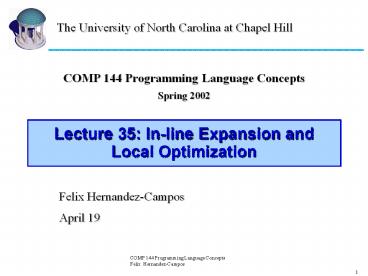COMP 144 Programming Language Concepts - PowerPoint PPT Presentation
Title:
COMP 144 Programming Language Concepts
Description:
function max(a, b : integer) return integer is. begin. if a b then return a; else return b; end if; end max; pragma inline (max) ... – PowerPoint PPT presentation
Number of Views:26
Avg rating:3.0/5.0
Title: COMP 144 Programming Language Concepts
1
Lecture 35 In-line Expansion and Local
Optimization
The University of North Carolina at Chapel Hill
- COMP 144 Programming Language Concepts
- Spring 2002
Felix Hernandez-Campos April 19
2
Phases
3
Subroutine In-line Expansion
- Subroutines may be expanded in-line at the point
of the call - Rather than use a stack-based calling convention
- In-line expansion saves subroutine overheads and
help code improvement - In-line expansion may be decided by the compiler
based on some optimization heuristics - E.g. short, non-recursive subroutines are always
in-lined in some languages
4
Subroutine In-line Expansion
- In-line expansion can also be suggested by the
programmer - E.g. C
- inline int max (int a, int b)
- return a gt b ? a b
- E.g. Ada
- function max(a, b integer) return integer is
- begin
- if a gt b then return a else return b end if
- end max
- pragma inline (max)
5
Macros and In-line Expansion
- What is the difference between a macro and a
programmer suggested expansion? - Optional in the second case
- Most importantly, in-line expansion is an
implementation technique with no effect in
program semantics - E.g.
- define MAX(a,b) ((a) gt (b) ? (a) (b))
- No type checking
- What happens after MAX(x, y)?
- The larger argument is incremented twice
6
In-line Expansion
- In-line expansion has some disadvantages
- Increase in code size
- It cannot be used with recursive subroutines
- It is sometimes useful to expand the first case
in a recursion subroutine - Optimize the common
- case rule
Most hash chains are only one bucket long
7
Phases
8
Example Control Flow Graph
- Basic blocks are maximal-length set of sequential
operations - Operations on a set of virtual registers
- Unlimited
- A new one for each computed value
- Arcs represent interblock control flow
9
Redundancy Elimination in Basic Blocks
- We will consider the example on the right
- It computes the binomial coefficients
- for 0 ? m?n
- It is based on
10
Syntax Tree for the combinations subroutine
11
Naïve Control Flow Graph for the combinations
subroutine
12
Naïve Control Flow Graph
- Uses virtual registers
- A new register for each new value
- ra is the return addres, fp is the frame pointer
- n, A, I and t perform the appropriate
displacement addressing with respect to the stack
pointer (sp) register - Parameter passing using r4 and r5
13
Value Numbering
- How can we eliminate redundant loads and
computations? - Expression DAG
- Value numbering
- In value numbering, the compilers assigns the
same name (i.e., number) to any two or
symbolically equivalent computations (i.e.,
values) - A dictionary is used to keep track of values that
have already been loaded or computed
14
Value Numbering
- If a value is already in a register, reuse that
register - E.g., the load instruction can be eliminated vi
x if the value x is already in register vj - Replace all uses of vi by vj
- Similarly, we can get rid of small constants
using immediate value
15
Value Numbering
- In vi vj op vk, we can use constant folding if
the values in vj and vk are known to be constants - Local constant folding and constant propagation
- At the same time, strength reduction and useless
abstraction elimination - A key that combine the registers and the operator
is used to keep track of the previous operation
in the dictionary
16
Control Flow Graph for combinations after local
redundancy elimination and strength reduction
17
Reading Assignment
- Read Scott
- Sect. 8.2.3
- Ch. 13.3
18
Peephole OptimizationCommon Techniques
19
Peephole OptimizationCommon Techniques
20
Peephole OptimizationCommon Techniques
21
Peephole OptimizationCommon Techniques

